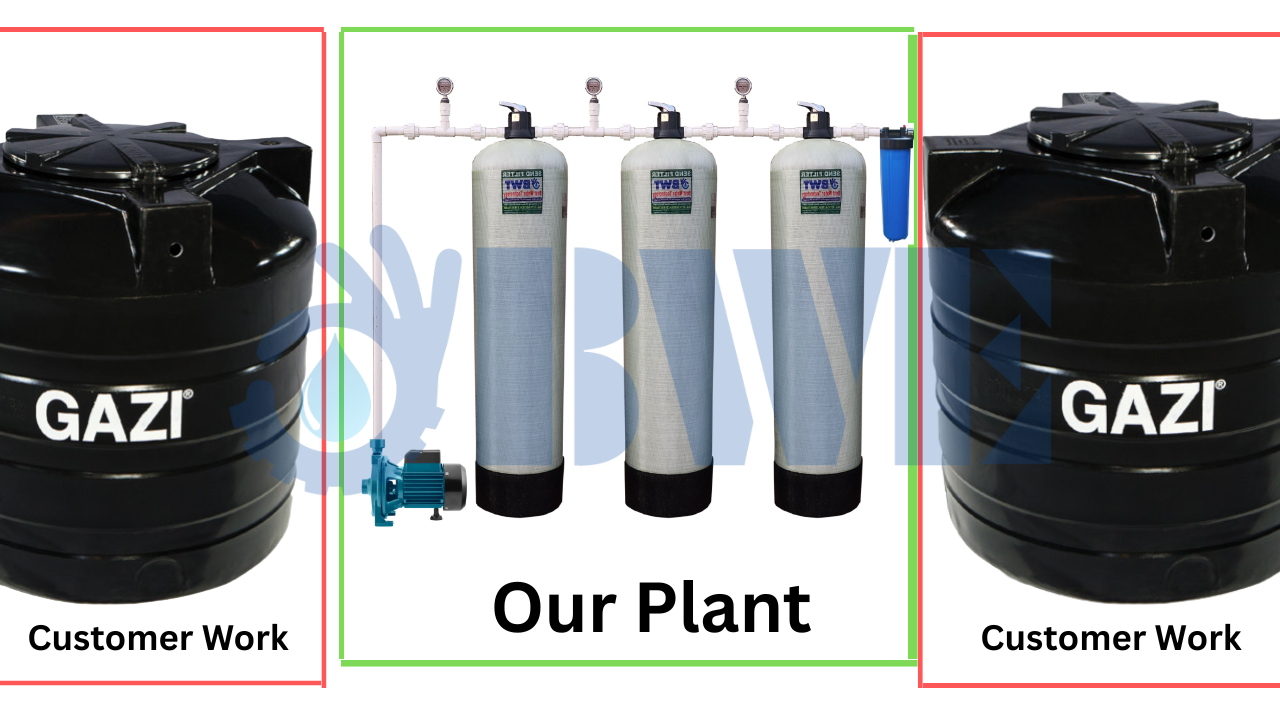Iron Removal Plant in Bangladesh: Essential for Clean, Safe Water
Iron contamination in water is a major concern in Bangladesh, affecting both urban and rural areas. High levels of iron in groundwater can cause several problems, including bad odor, rusty stains on clothes, and health issues. To address this issue, iron removal plants have become essential for providing clean water for households and businesses. Combined with water purifiers, these systems can offer the best solution for pure and safe water in Bangladesh.
In this article, we’ll explore everything you need to know about iron removal plants, how they work, and why they are crucial for Bangladeshi homes. We’ll also discuss how water purifiers complement these systems to ensure the highest water quality.
Table of Contents
- Understanding Iron Contamination in Bangladesh
- What is an Iron Removal Plant?
- How Does an Iron Removal Plant Work?
- Why Iron Removal is Important for Health and Appliances
- Iron Removal Plant vs Water Purifier: What’s the Difference?
- Key Features of Iron Removal Plants
- Types of Iron Removal Plants
- Choosing the Right Iron Removal Plant for Your Home in Bangladesh
- Enhancing Water Quality with Water Purifiers
- The Cost of Iron Removal Plants in Bangladesh
- Conclusion: The Need for Iron Removal Plants and Water Purifiers in Bangladesh
1. Understanding Iron Contamination in Bangladesh
Iron contamination is a widespread problem across Bangladesh, especially in regions that rely on groundwater for daily water needs. The geological composition of Bangladesh’s soil leads to the dissolution of iron into the groundwater. While iron is a naturally occurring element, its excess levels in water can cause multiple problems, such as:
- Rusty Stains: High iron content leads to rust stains on clothes, kitchenware, and bathroom fittings.
- Metallic Taste: Water with high iron levels often has an unpleasant metallic taste.
- Health Concerns: Prolonged consumption of iron-rich water may lead to gastrointestinal issues and other health problems.
- Clogged Pipes: Iron buildup can clog pipes, reducing water flow and damaging water appliances.
As a result, many homes and industries are turning to iron removal plants to purify their water. But what exactly is an iron removal plant, and how does it work?
2. What is an Iron Removal Plant?
An iron removal plant is a specialized water filtration system designed to remove iron and other heavy metals from water. These systems are essential in areas with high iron contamination, where conventional water purifiers may not be effective.
The primary goal of an iron removal plant is to treat water by filtering out iron particles and ensuring it is free from impurities that can affect taste, appearance, and usability. These systems can be installed at the source of the water supply, ensuring that all water used in the household is clean and safe.
3. How Does an Iron Removal Plant Work?
The operation of an iron removal plant involves several stages to effectively filter iron from the water:
- Oxidation: The first step in removing iron from water is to oxidize dissolved iron (Fe2+) into its insoluble form (Fe3+). This can be achieved by exposing the water to air, chlorine, or other oxidizing agents.
- Filtration: Once the iron is oxidized, it turns into solid particles that can be filtered out. The filtration process typically uses sand, gravel, or special filter media designed for iron removal. These filters trap the iron particles, preventing them from passing through.
- Backwashing: Over time, the filter media becomes clogged with iron particles. To maintain the system’s efficiency, the plant undergoes a backwashing process where water is flushed backward through the filter to remove the accumulated particles.
- Final Polishing: In some systems, a final polishing filter may be used to ensure all traces of iron and other impurities are removed, delivering clean, iron-free water.
4. Why Iron Removal is Important for Health and Appliances
The high levels of iron in water can have several negative effects on both health and household appliances:
- Health Impact: While iron is an essential nutrient, consuming water with excessive iron levels over time can lead to health issues, particularly affecting the digestive system. It may also lead to skin irritation when used for bathing.
- Appliance Protection: Iron buildup in water pipes and appliances like washing machines, water heaters, and dishwashers can cause clogging and reduce their lifespan. Regular exposure to iron-contaminated water can lead to higher maintenance and replacement costs for appliances.
- Improved Taste and Appearance: Iron-rich water often has a metallic taste and a reddish-brown appearance, making it unpalatable. Removing iron improves both the taste and the clarity of the water.
5. Iron Removal Plant vs Water Purifier: What’s the Difference?
One common question is whether an iron removal plant is the same as a water purifier. While both systems aim to improve water quality, they serve different purposes.
- Iron Removal Plant: This system is specifically designed to remove iron and other heavy metals from the water. It is ideal for households where iron contamination is a significant problem.
- Water Purifier: A water purifier focuses on removing biological contaminants, such as bacteria, viruses, and harmful chemicals. While some purifiers may also remove a small amount of iron, they are not as effective as dedicated iron removal systems.
For homes with iron-contaminated water, it is often recommended to use both an iron removal plant and a water purifier. The iron removal plant will filter out the heavy metals, while the water purifier will ensure the water is free from harmful pathogens.
6. Key Features of Iron Removal Plants
When choosing an iron removal plant for your home in Bangladesh, it’s essential to look for certain features:
- Durable Filtration Media: High-quality filter media such as Birm, Greensand, or manganese dioxide are effective in removing iron and manganese from the water.
- Easy Maintenance: A good iron removal plant should come with easy maintenance features such as automatic backwashing to keep the system clean without manual intervention.
- High Flow Rate: Ensure that the system has a high flow rate, so it can supply enough water for your household needs without slowing down water pressure.
- Compact Design: Space can be a concern for many homes in Bangladesh, so choosing a compact iron removal plant that can fit into small spaces is essential.
7. Types of Iron Removal Plants
There are several types of iron removal plants available in Bangladesh, each with its advantages:
- Sand Filter Plants: These use a bed of sand to filter out iron particles after oxidation.
- Birm Media Filters: Birm is a highly effective media for removing iron and manganese without the need for chemicals.
- Greensand Filters: Greensand filters use manganese dioxide to oxidize and remove iron, manganese, and hydrogen sulfide from water.
- Catalytic Carbon Filters: These filters use activated carbon combined with catalytic properties to remove iron and improve the taste and odor of water.
8. Choosing the Right Iron Removal Plant for Your Home in Bangladesh
When selecting an iron removal plant for your home, consider the following factors:
- Water Quality Test: Conduct a water test to determine the levels of iron and other contaminants in your water. This will help you choose the right type of iron removal system.
- Capacity: Choose a system that matches the daily water consumption of your household or business.
- Installation and Maintenance: Opt for a system that is easy to install and comes with low maintenance requirements.
9. Enhancing Water Quality with Water Purifiers
To ensure the highest quality water, many households in Bangladesh are now combining iron removal plants with water purifiers. This combination addresses both the physical and biological contaminants in water, making it completely safe for drinking, cooking, and daily use.
Popular types of water purifiers in Bangladesh include RO (Reverse Osmosis) systems, UV purifiers, and Ultrafiltration (UF) systems. These purifiers work alongside iron removal plants to eliminate bacteria, viruses, and harmful chemicals, providing comprehensive water treatment solutions.
10. The Cost of Iron Removal Plants in Bangladesh
The cost of iron removal plants in Bangladesh varies depending on the size and type of system. A basic domestic iron removal plant can cost between BDT 10,000 to BDT 50,000, while larger, industrial systems may be more expensive.
When calculating the total cost, it’s essential to consider not only the purchase price but also the cost of maintenance, including filter replacements and backwashing.
Conclusion: The Need for Iron Removal Plants and Water Purifiers in Bangladesh
With the increasing levels of iron contamination in Bangladesh’s water sources, iron removal plants have become a necessity for many households and businesses. These systems effectively filter out iron and other heavy metals, protecting health, household appliances, and ensuring clean, usable water. When combined with a water purifier, you can ensure the highest quality water for your family.
Investing in an iron removal plant is a smart choice for anyone in Bangladesh facing issues with iron-rich water. By providing clean, iron-free water, these systems improve both the quality of life and the longevity of household appliances. Be sure to choose the right system that fits your needs and budget, and enjoy the benefits of pure water for years to come.







